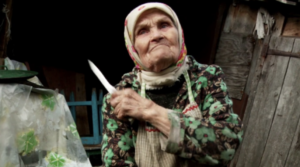
Still from ‘Babushkas,’ Chicken and Egg Pictures
The Babushkas of Chernobyl is a 2015 documentary produced and directed by Holly Morris and Anne Bogart, which emerged from Morris’ earlier journalism and TED Talk about elderly women living in the shadow of the destroyed Chernobyl nuclear plant. It is available on several streaming platforms.
Chernobyl became a household word in 1986 when the plant melted down and exploded due to poor design and inadequately trained staff. Five million people lived in areas of Ukraine, Belarus, and Russia that were contaminated. The International Atomic Energy Agency says 200,000 were forcibly evacuated from a 30-kilometer radius around the Ukrainian plant—more than 1,000 square miles—that became known as the Exclusion Zone, part of which, according to National Geographic, will not be habitable for at least 20,000 years.
The dispersal of radioactive material caused many deaths and thousands of cancers, though the numbers are contested. The World Nuclear Association, an industry mouthpiece, says only 30 died; the UN Chernobyl Forum claimed “no more than 4,000”; while a report commissioned by Green Party members of the European Parliament said the figure could reach 60,000.
Events such as Chernobyl and Fukushima—the two worst nuclear power disasters so far—are often seen as Promethean, since the technology we hoped would save us from fossil fuels created lasting horrors. They stay in the news as reminders of that betrayal and the humiliation of human intelligence.
Chernobyl was in the news again in February of this year, when Russian soldiers attacked and occupied the defunct plant and its Zone, with subsequent reports of their possible health problems. Yesterday four Ukrainian academics addressed an open letter to Noam Chomsky about, among other things, the dangers of Russian control of other Ukrainian nuclear plants.
Babushkas, though, is primarily a portrait of Hanna Zavorotyna, Maria Shovkuta, and Valentyna Ivanivna, three of the 100 or so (at that time) people living on “some of the most toxic land on earth.” Many of them escaped the Soviets’ forced relocations and walked as far as 70 kilometers to return to their ancestral homes. “Almost all of them” were women.
(I cannot find consistent data on how many still live in the Zone, and Holly Morris has not responded to a query about the current fate of the women she filmed, especially after the Russian invasion. They would be in their late 80s or 90s now.)
The film starts with a chipper young government minder insisting, in good English, “The Exclusion Zone is officially deserted. It’s all closed forever,” but later she is shown visiting one of the babushkas and cautiously eating as little as possible of the food she is offered.
The trio profiled, who live in different former villages, are saucy and full of good humor. They grow and prepare their own food, raise chickens, plant bulbs at family graveyards, and fish waterways.
“Even though I’m small, I’m very hardworking,” one says.
They insist, in fact, that they live healthier lives than those who were evacuated to distant cities. “Other people come back to visit, after having been evacuated, and they walk like this,” one says, creeping along in faux-pain. “I’m like this,” she says and runs off in her gumboots and head scarf. The trio are contrasted with eight other women who were evacuated and still weep and dream of returning to their homes. “Motherland is Motherland,” one says.
A doctor or nuclear technician later in the film claims mortality rates were higher among those who left, due to “socio-psychological” factors, but at the time he is using a spectrometer to measure how much Cesium 137 one of the babushkas has in her body. Everyone including the woman looks worried. The three claim to know which pockets of land are safer than others, but they all look shocked when scientists’ radiation gauges sound alarms. An American writer in the film says they were only allowed to remain there in the first place because they were likely to die of other problems of old age before cancer could kill them.
The film mostly evades judgement on the women’s choice by presenting them as utterly charming. “I’m not afraid of anything, darling,” one says, after reminiscing about meeting her husband in Kiev and dancing.
During a visit two sing at a table covered with food: “We drank vodka and we’ll be drinking more, and whoever makes fun of us will be beaten up.” “Goodbye brains, see you tomorrow,” one toasts.
Another rues the day she met her husband, who drank and took all the money. He has died three years earlier, and “now I have everything,” she says, laughing. They sing and dance together, keeping time with garden implements, and one is shown after the party, staggering away at a rapid pace under an umbrella in the pouring rain. The women—“girls,” they call themselves—have suffered terribly in their lives, from Stalin’s famine, the war, hardship, and loss as uncontrollable as fate.
“My mother planted marigolds and taught me to sing songs of spring about my blossoming hopes,” one sings, after returning from the only church service of the year, a midnight Easter mass.
“Each person should live where their soul desires,” she says. “And so my life goes on.”
